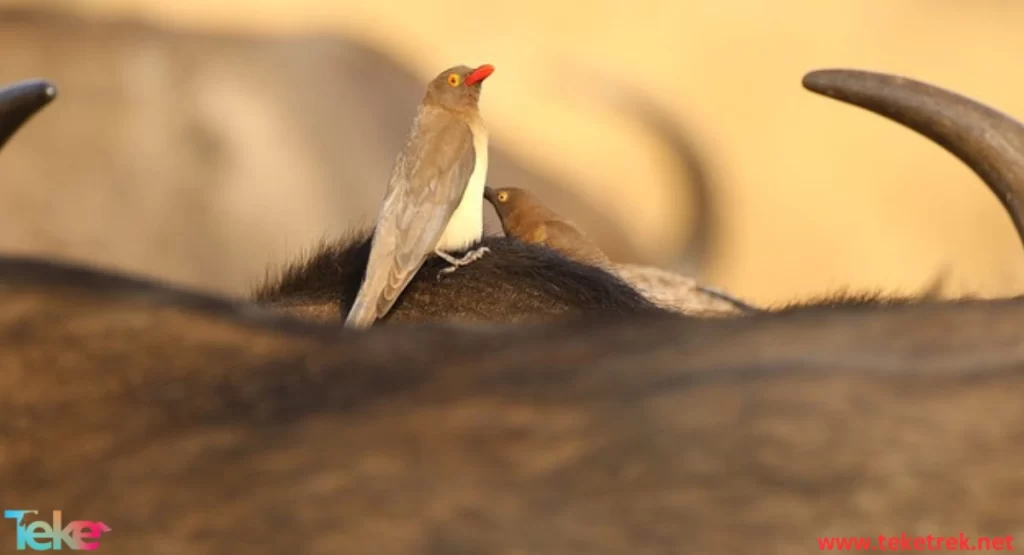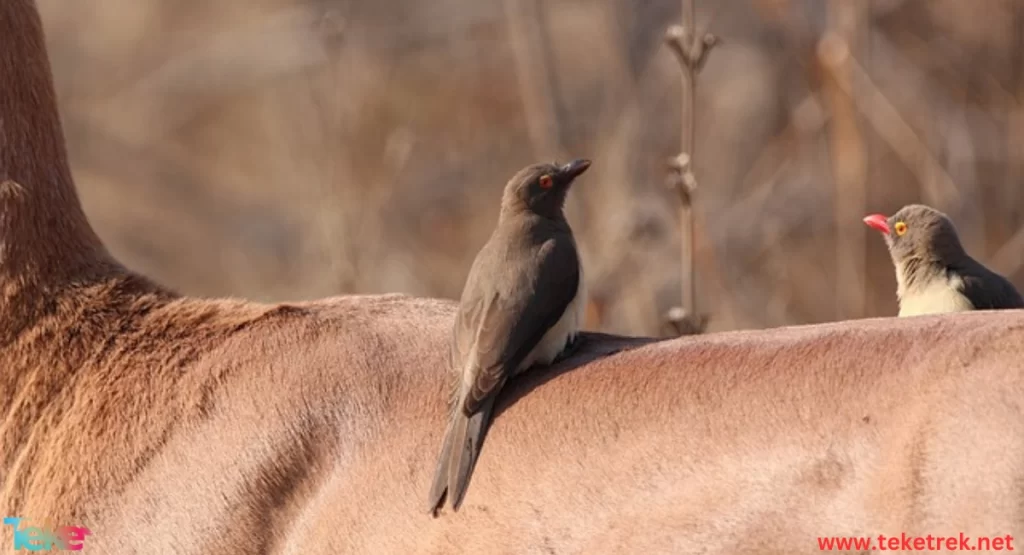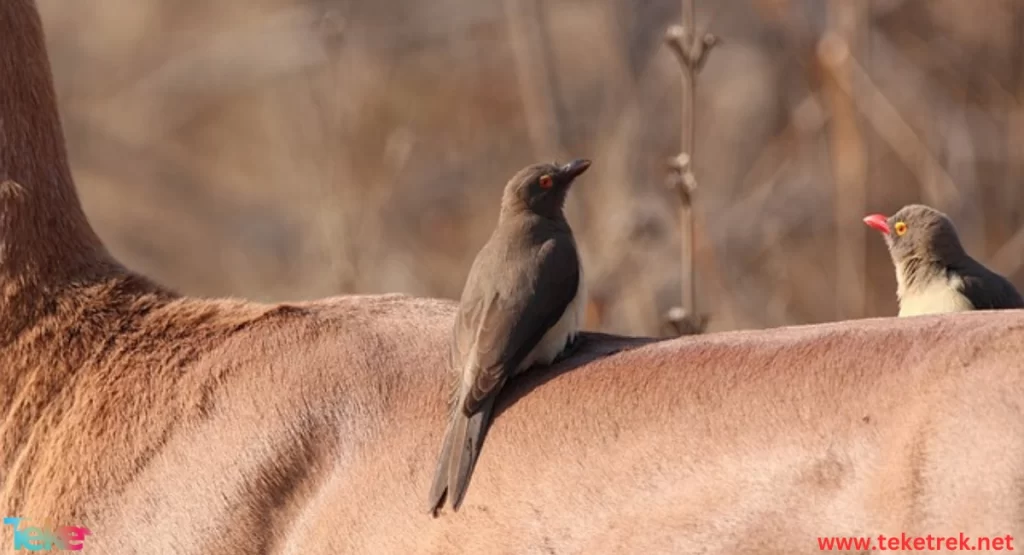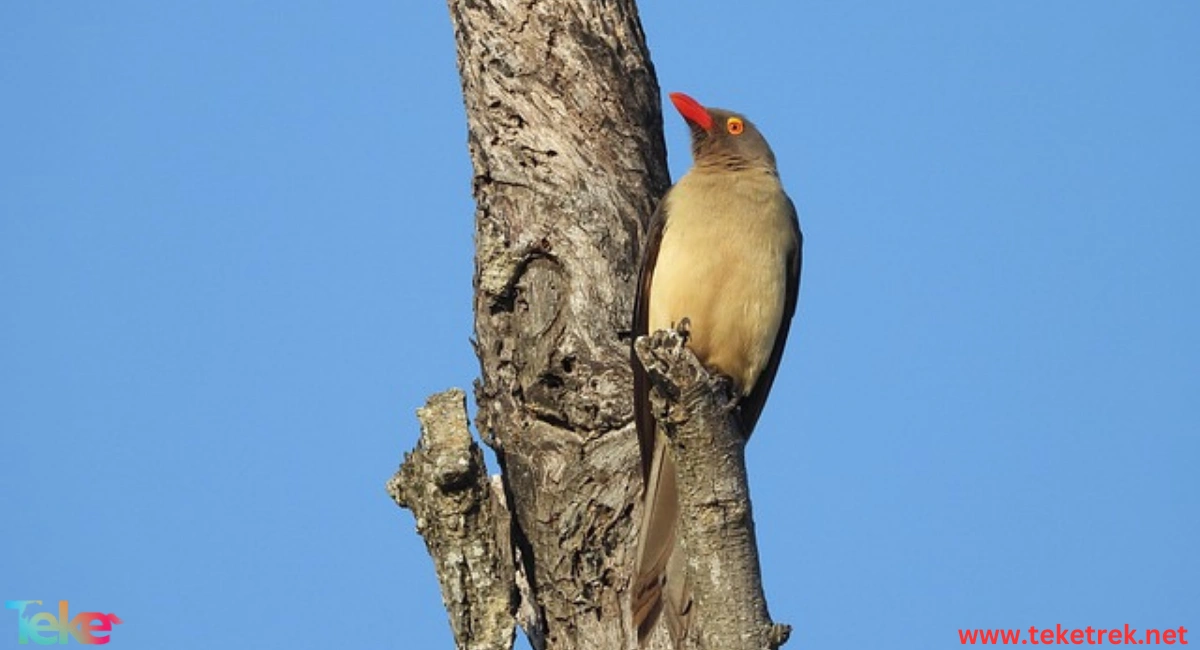The brown-colored, medium-sized parasitic Oxpecker bird. Below we talk on TekeTrek more about how it lives, reproduces, and feeds, and we list the most important facts about it.

About the Oxpecker
The Oxpecker is a medium-sized bird, classified within the subfamily of Starlings (Sturnidae).
- It belongs to the eukaryotes of the kingdom Animalia, the family Chordata, the order Passeriformes, the family Buphagidae, of the genus Buphagus.
- Its color is darker brown, its beak is dark olive, and then it gradually takes on color after four months.
- A crackling, hissing sound.
- Its length is 20 cm, and its weight ranges from 57 to 70 grams.
- The Buphagidae family includes only two species, the yellow-billed oxpecker and the red-billed oxpecker.
- The “oxpecker” is named for its habit of perching on large wild and domestic mammals to feed on the ticks found on them.
- It differs from the starling in the shape of the beak and short, sharply curved claws.
- The adult of the nominate race has dark brown to olive-grey upperparts, including the upper wing and tail.
- But there is a contrast with the light yellowish rump and upper tail coverts that show a greyish wash.
- The underparts are pale brown from the breast to the undertail coverts.
- The head and throat are similar to the upper parts.
- The laterally flattened bill has a broad lower base and a swollen colmen near the tip.
- The oxpecker’s eyes are narrow and red or orange.
- The legs and feet are dark brown to black.
Oxpecker habitat
Oxpeckers are found in the eastern savannas of sub-Saharan Africa, extending through Ethiopia and Somalia through Kenya, Tanzania, Malawi and Zambia between the Central African Republic and South Sudan, Africa, Botswana, Zimbabwe and Mozambique to northern and eastern South Africa.
- It nests in tree holes lined with hair plucked from livestock.
- Forms large flocks outside the breeding period.
- The Buphagidae family is endemic to sub-Saharan Africa.
- While Buphagus erythrorhynchus is endemic in the eastern part of sub-Saharan Africa.
What does an oxpecker eat?
The oxpecker is a carnivorous animal that feeds on insects:
- An adult eats about 100 Rhipicephalus (Boophilus) decoloratus insects, or 12,000 larvae obtained from the skin of mammals.
- They prefer blood, as they take ticks swollen with blood. They also peck mammals’ wounds to keep them open and feed directly on their blood, thus encouraging more parasites to settle on them.
Oxpecker’s relationship with mammals
The Oxpecker perches on large mammals, whether wild or domestic, and establishes a relationship with them that may be symbiotic or parasitic:
- It eats parasites such as ticks and bot fly larvae from the skin of mammals. In a symbiotic relationship, the bird obtains food and rids the mammals of parasites.
- However, Oxpecker prefers blood, as it eats blood-filled ticks, but it pecks the host’s wounds to keep them open, and feeds on its blood directly, thus encouraging more parasites to settle on it, so the relationship is considered parasitic in nature.
- The red bill uses a scissor movement to search for insects in the host’s hair. While yellowbills use a clicking motion, due to the thickness of their beaks.
- Oxpeckers prefer short-haired animals such as buffalo and rhinoceroses.
- You find the Oxpecker bird inside the ears of animals searching for food, as most animals tolerate this.
- But they do not get along with elephants, which use their tail, trunk or ears to chase them, perhaps because they do not have sebaceous glands that produce the sebum that attracts ticks.
Reproduction in oxpeckers
The Oxpecker reproduces by laying two to five eggs, or on average three eggs.
Oxpecker and extinction
The Oxpecker was classified as an extinct animal in South Africa in the 20th century, due to poaching of buffalo and rhinoceros and the outbreak of rinderpest.
- Also, the increased use of dipped cattle that contain arsenic caused the death of Oxpeckers that were feeding on dipped cattle, and thus their numbers decreased further. Today, dips containing organic phosphates and home drinks are used, which causes loss of oxibir.
- Reinstatement to the Kruger National Park has resulted in the proliferation of breeding colonies, thus moving the species from extinct to endangered.
- But the bird’s numbers continue to decline due to the use of pesticides. It harms livestock due to the worsening of wounds when the number of ticks decreases to supplement its diet.
- Therefore, there must be a continuous effort to work with farmers to find solutions to these problems, including moving the bird from areas where it is widespread to areas where it is no longer widely present.
Interesting facts about the Oxpecker
What are some interesting facts about oxpecker birds?
- The name “oxpecker” comes from its habit of perching on wild and domestic mammals to remove ticks from them.
- The Oxpecker is classified in the starling family but differs from it in the form of its beak and short, sharply curved claws.
- Oxpeckers are an endangered animal.
- Oxpeckers are associated with mammals in a relationship that is sometimes classified as symbiotic and sometimes parasitic.


FAQ
The most common questions about the Oxpecker:
- Where does the Oxpecker live?
The Oxpecker lives in the African Sahara.
- Is the Oxpecker in danger of extinction?
Yes, the Oxpecker is threatened with extinction.
- Why was the Oxpecker classified as an extinct species?
The Oxpecker is classified as an extinct species due to overhunting
- How do oxpeckers reproduce?
Oxpeckers reproduce by eggs.
- Why is it called oxpecker?
It comes from its habit of perching on wild and domestic mammals to remove ticks from them.
In short, the Oxpecker is a carnivorous animal that feeds on insects and reproduces with eggs that help remove parasites. It is also one of the endangered animals.






